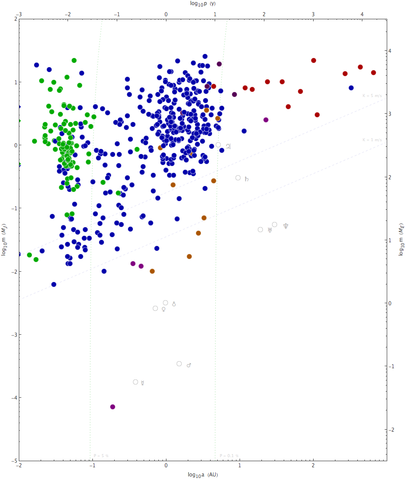 |
This is a file from the Wikimedia Commons. Information from its description page there is shown below.
Commons is a freely licensed media file repository. You can help.
|
 |
This diagram image could be recreated using vector graphics as an SVG file. This has several advantages; see Commons:Media for cleanup for more information. If an SVG form of this image is already available, please upload it. After uploading an SVG, replace this template with {{ vector version available|new image name.svg}}. |
Summary
| Description |
English: Scatter plot of mass, m, and semimajor axis, a, for exoplanet discoveries through 2010-10-03, indicating the discovery method using distinct colors: radial velocity (dark blue)
transit (dark green)
timing (dark purple)
astrometry (dark yellow)
direct imaging (dark red)
microlensing (dark orange)
pulsar timing (purple)
Solar System planets for reference
Estimates (see "important note" below) of m and a are indicated with circles; or with small triangles along the m axis where no a value is provided in the Extrasolar Planets Encyclopaedia, and none can be calculated (from given stellar mass and period).
Scales indicate (log10 of) mass, m, expressed as Jupiter masses (left) and Earth masses (right); and (log10 of) semimajor axis, a, expressed in AU (bottom), and the corresponding period, p for a planet orbiting a Sun-mass star, expressed in Earth years.
Reference lines are provided as a rough measure of the difficulty of detecting exoplanets using radial velocity and transits. Dashed lines trace the combinations of m and a values that produce the indicated radial velocity semi-amplitude K for a planet orbiting a solar-mass star (assuming m << M). Dotted lines trace the m (for Jupiter-density) and a values where the geometric probability of transit for a solar-radius star (assuming a circular orbit, so that e and ω can be ignored) is the indicated value (less than the indicated proportion of all planets to the right of a given line will have transiting orbits).
Base data is from the Extrasolar Planets Encyclopaedia, augmented with discovery methods from the Planetary Society's Catalog of Exoplanets and updates from the Kepler Mission's summary table of discoveries. Occasional missing data is determined from original papers cited by these sources.
- ↑ Extrasolar Planets Encyclopaedia (2010-09-30). Retrieved on 2010-10-03.
- ↑ Planetary Society: Catalog of Exoplanets (2010-01-07). Retrieved on 2010-10-03.
- ↑ Summary Table of Kepler Discoveries. NASA (2010-08-26). Retrieved on 2010-10-03.
|
| Date |
3 October 2010 |
| Source |
Own work, based on a figure by E.A.L. and used with permission |
| Author |
Aldaron, a.k.a. Aldaron |
Licensing
| Public domainPublic domainfalsefalse |
 |
I, the copyright holder of this work, release this work into the public domain. This applies worldwide.
In some countries this may not be legally possible; if so:
I grant anyone the right to use this work for any purpose, without any conditions, unless such conditions are required by law.Public domainPublic domainfalsefalse
|
File usage
The following pages on Schools Wikipedia link to this image (list may be incomplete):
Wikipedia for Schools was collected by SOS Children. Thanks to SOS Children, 62,000 children are enjoying a happy childhood, with a healthy, prosperous future ahead of them. There are many ways to help with SOS Children.





